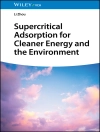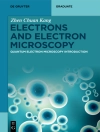Volume XVII in the ‘Advances in Electrochemical Science and Engineering’ series, this monograph covers progress in this rapidly developing field with a particular emphasis on important applications, including spectroscopy, medicinal chemistry and analytical chemistry.
As such it covers nanopatterned and nanoparticle-modified electrodes for analytical detection, surface spectroscopy, electrocatalysis and a fundamental understanding of the relation between the electrode structure and its function.
Written by a group of international experts, this is a valuable resource for researchers working in such fields as electrochemistry, materials science, spectroscopy, analytical and medicinal chemistry.
विषयसूची
List of Contributors XI
Series Preface XVII
Preface XIX
1 Surface Electrochemistry with Pt Single-Crystal Electrodes 1
Victor Climent and Juan M. Feliu
1.1 Introduction 1
1.2 Concepts of Surface Crystallography 2
1.3 Preparation of Single-Crystal and Well-Oriented Surfaces 9
1.4 Understanding the Voltammetry of Platinum 13
1.4.1 CO Charge Displacement Experiment 15
1.4.2 Stepped Surfaces 18
1.5 Potential of Zero Charge of Platinum Single Crystals 24
1.5.1 Total Charge Curves in Coulometric Analysis 29
1.5.2 Model for the Estimation of the Potential of Zero Free Charge 32
1.5.3 Applications of Electrocapillary Equation 32
1.6 The Laser-Induced Temperature Jump Method and the Potential of Maximum Entropy 34
1.7 Electrocatalytic Studies with Single-Crystal Electrodes 40
1.7.1 Carbon Monoxide on Platinum 40
1.7.2 Oxygen Reduction 43
1.8 Concluding Remarks 47
Acknowledgments 49
References 49
2 Electrochemically Shape-Controlled Nanoparticles 59
Lu Wei, Na Tian, Zhi Y. Zhou, and Shi G. Sun
2.1 Introduction 59
2.2 Metal Nanoparticles of High-Index Facets and High Surface Energy 60
2.2.1 NPs of {hk0} High-Index Facets 61
2.2.2 NPs of {hkk} High-Index Facets 66
2.2.3 NPs of {hhl} High-Index Facets 66
2.2.4 NPs of {hkl} High-Index Facets 69
2.2.5 Electrochemistry-Mediated Shape Evolution 71
2.2.6 Electrochemical Milling and Faceting 72
2.3 Metallic Alloy Nanoparticles of High-Index Facets and High Surface Energy 73
2.3.1 Pd–Pt Alloy NPs 74
2.3.2 Pt–Rh Alloy NPs 76
2.3.3 Fe–Ni Alloy NPs 77
2.4 Metal Nanoparticles of Low-Index Facets 79
2.4.1 Fe NPs with High Surface Energy 79
2.4.2 Cu NPs 81
2.4.3 Pt NPs 83
2.5 Nanoparticles of Metal Oxides and Chalcogenides 84
2.5.1 Cuprous Oxide 84
2.5.2 Lead Sulfide 89
2.6 Summary and Perspectives 90
Acknowledgment 91
References 91
3 Direct Growth of One-, Two-, and Three-Dimensional Nanostructured Materials at Electrode Surfaces 97
Sapanbir S. Thind and Aicheng Chen
3.1 Introduction 97
3.2 Growth of 1D Nanomaterials 98
3.3 Nanowires 98
3.3.1 Formation of Na2Ti6O13, H2Ti3O7, and Ti O2 Nanowires 99
3.3.2 Synthesis of Various Nanowires Using Porous Anodic Alumina (PAA) Templates 104
3.3.3 Ti O2 Nanowires through Thermal Oxidation Treatment 106
3.4 Nanorods 108
3.4.1 Effect of Oxygen Source on the Formation of Titanium Oxide Films 110
3.5 Nanotubes 113
3.5.1 Nanotube Growth Control 116
3.5.2 Modification of Ti O2 Nanotubes 119
3.6 Direct Growth of Two-Dimensional Nanomaterials 121
3.6.1 Nanoplates 121
3.6.2 Graphene Oxide Nanosheets 126
3.7 Growth of Three-Dimensional Nanomaterials 128
3.7.1 Nanodendrites 128
3.7.2 Nanoflowers 130
3.8 Summary 135
Acknowledgments 136
References 136
4 One-Dimensional Pt Nanostructures for Polymer Electrolyte Membrane Fuel Cells 145
Gaixia Zhang and Shuhui Sun
4.1 Introduction 145
4.2 Shape-Controlled Synthesis of 1D Pt Nanostructures 146
4.2.1 1D Pt Nanowires/Nanorod and Nanotubes 148
4.3 1D Pt-Based Nanostructures as Electrocatalysts for PEM Fuel Cells 176
4.3.1 Reaction Mechanisms for PEMFCs 176
4.3.2 Cathode Catalysts for ORR in DHFC 176
4.3.3 Anode Catalysts for MOR in DMFC 181
4.3.4 Anode Catalysts for FAOR in Direct Formic Acid Fuel Cell (DFAFC) 185
4.4 Conclusions and Outlook 189
References 190
5 Investigations of Capping Agent Adsorption for Metal Nanoparticle Stabilization and the Formation of Anisotropic Gold Nanocrystals 199
Ian J. Burgess
5.1 Introduction and Scope 199
5.2 The Multifunctional Role of Nanoparticle Capping Agents 199
5.3 Controlled Growth of Anisotropic Nanoparticle 201
5.4 Measuring Capping Agent Adsorption 202
5.5 Experimental Techniques 203
5.5.1 Single-Crystal Gold Electrode Preparation 203
5.5.2 Chronocoulometry and the Back-Integration Technique 205
5.5.3 Gibbs Excesses of the Acid/Base Forms of the Capping Agents 205
5.5.4 Gibbs Excesses of Co-adsorbed Capping Agents 207
5.6 Citrate-Stabilized Nanoparticles 208
5.6.1 Citrate Adsorption on Au(111) Electrodes 208
5.6.2 Citrate-Stabilized Gold Nanoparticles 210
5.7 Quaternary Ammonium Surfactants as Capping Agents 212
5.7.1 Model Surfactant Adsorption on Gold Single Crystals 212
5.7.2 Halide Co-adsorption on Gold Single Crystals 214
5.7.3 Implications for Nanoparticle Systems 215
5.8 Pyridine Derivative Capping Agents 217
5.8.1 4-Dimethylaminopyridine (DMAP)-Stabilized Au Nanoparticles 217
5.8.2 DMAP Adsorption on Polycrystalline Au 219
5.8.3 Competitive Adsorption Effects 226
5.8.4 DMAP Adsorption on Single-Crystal Au Surfaces 229
5.8.5 Directed Growth Using DMAP as a Capping Agent 231
5.8.6 4-Methoxypyridine (MOP)-Stabilized Au Nanoparticles 235
5.9 Conclusions and Perspectives 239
Acknowledgments 239
References 240
6 Intercalation of Ions into Nanotubes for Energy Storage – A Theoretical Study 247
Leila Mohammadzadeh, Aleksej Goduljan, Fernanda Juarez, Paola Quaino, Elizabeth Santos, and Wolfgang Schmickler
6.1 Introduction 247
6.2 Ionization in Nanotubes 248
6.3 Electrostatic Interactions 250
6.4 Details of the Investigated Systems 251
6.5 Ionic Charges 252
6.6 Effect of Ion Insertion on the Band Structure 253
6.7 Screening of the Coulomb Potential 255
6.7.1 Potential along the Axis 255
6.7.2 Effective Image Radius 257
6.8 Energetics of Ion Insertion 259
6.8.1 Optimum Position 259
6.8.2 Insertion Energies in CNTs 261
6.8.3 Ions in Gold Nanotubes 262
6.9 Capacity of a Narrow Nanotube in Contact with an Ionic Liquid 264
6.10 Other Literature 266
6.11 Outlook 267
Acknowledgments 268
References 268
7 Surface Spectroscopy of Nanomaterials for Detection of Diseases 271
Jean F. Masson and Kristy S. Mc Keating
7.1 An Introduction to Plasmonics 271
7.2 An Overview of Plasmonic Techniques 272
7.2.1 Surface Plasmon Resonance (SPR) 272
7.2.2 Surface-Enhanced Raman Spectroscopy (SERS) 274
7.2.3 Metal-Enhanced Fluorescence (MEF) 276
7.2.4 Electrically Conductive Plasmonic Substrates 278
7.3 Plasmonic Spectroelectrochemistry 279
7.3.1 Electrochemical SPR and LSPR 279
7.3.2 Electrochemical SERS 282
7.3.3 Metal-Enhanced Fluorescence Electrochemistry 284
7.4 Plasmonic Biosensing for the Detection of Diseases 285
7.5 Outlook and Perspectives 287
References 288
8 Raman Spectroscopy at Nanocavity-Patterned Electrodes 295
Philip N. Bartlett
8.1 Introduction 295
8.2 Fabrication Methods 295
8.2.1 Top Down 295
8.2.2 Bottom-Up or Self-Organizing Approaches 299
8.2.3 Metal Evaporation 301
8.2.4 Electrodeposition 304
8.3 Plasmonics 307
8.3.1 Plasmonics of Nanohole Arrays 310
8.3.2 Sphere Segment Void (SSV) Plasmonics 310
8.4 Raman Spectroscopy 314
8.5 Surface-Enhanced Raman Spectroscopy 316
8.6 SERS on Nanohole Arrays 318
8.7 SERS at Sphere Segment Void (SSV) Surfaces 319
8.8 Some Applications in Electrochemical SERS 324
8.9 Other Surface-Enhanced Phenomena 324
8.10 Conclusions 326
Acknowledgment 327
References 327
9 Shell-Isolated Nanoparticle-Enhanced Raman Spectroscopy (SHINERS) of Electrode Surfaces 339
Jian F. Li, Rajapandiyan Panneerselvam, and Zhong Q. Tian
9.1 Introduction 339
9.2 Advantages of Isolated Mode over Contact Mode 342
9.3 3D-FDTD Simulations 343
9.4 Synthesis of SHINs 345
9.5 Characterization of SHINs 348
9.6 Applications of SHINERS in Electrochemistry 350
9.6.1 SHINERS Study of Pyridine Adsorption on Au(hkl) and Pt(hkl) Single-Crystal Electrodes 351
9.6.2 SHINERS for Probing the Benzotriazole Film Formation on Cu(100), Cu(111), and Cu(Poly) Electrodes 353
9.6.3 SHINERS Study of Ionic Liquids at Single-Crystal Electrode Surfaces 354
9.6.4 In Situ Investigation of Electrooxidation Processes at Gold Single-Crystal Surfaces 357
9.6.5 Quantitative Analysis of Temporal Changes in the Passive Layer at a Gold Electrode Surface 359
9.7 Summary and Outlook 361
Acknowledgments 362
References 362
10 Plasmonics-Based Electrochemical Current and Impedance Imaging 373
Xiaonan Shan, Yixian Wang, and Nongjian Tao
10.1 Introduction 373
10.2 Principle of Plasmonics-Based Electrochemical Current Microscopy (PECM) 374
10.2.1 Electrochemical Reactions 374
10.2.2 Relationship between Current and SPR Signals 375
10.3 Principle of Plasmonics-Based Electrochemical Impedance Microscopy (PEIM) 377
10.4 Imaging Local Electrochemical Current by PECM 379
10.4.1 Experiment Setup 379
10.4.2 Mapping Local Redox Reactions with PECM 380
10.4.3 Detecting Trace Chemicals 381
10.4.4 Spatial Resolution and Current Detection Limit 383
10.4.5 Imaging Local Square-Wave Voltammetry 386
10.5 Imaging the Electrocatalytic Activity of Single Nanoparticles 389
10.5.1 Experiment 390
10.5.2 Imaging Electrocatalytic Current of Single Pt Nanoparticles 390
10.6 Mapping Local Quantum Capacitance of Graphene with PEIM 393
10.6.1 Experiments 394
10.6.2 Imaging Local Quantum Capacitance of Graphene 394
10.6.3 Quantum Capacitance 396
10.6.4 Local Quantum Capacitance and Charge Impurity Effect 398
10.7 Conclusions 398
References 399
Index 403
लेखक के बारे में
Richard C. Alkire is Professor Emeritus of Chemical & Biomolecular Engineering Charles and Dorothy Prizer Chair at the University of Illinois, Urbana, USA. He obtained his degrees at Lafayette College and University of California at Berkeley. He has received numerous prizes, including Vittorio de Nora Award and Lifetime National Associate award from National Academy.
Philip N. Bartlett is Head of the Electrochemistry Section, Deputy Head of Chemistry for Strategy, and Associate Dean for Enterprise in the Faculty of Natural and Environmental Sciences at the University of Southampton. He received his Ph D from Imperial College London and was a Lecturer at the University of Warwick and a Professor for Physical Chemistry at the University of Bath, before moving to his current position. His research interests include bioelectrochemistry, nanostructured materials, and chemical sensors.
Jacek Lipkowski is Professor at the Department of Chemistry and Biochemistry at the University of Guelph, Canada. His research interests focus on surface analysis and interfacial electrochemistry. He has authored over 120 publications and is a member of several societies, including a Fellow of the International Society of Electrochemistry.












